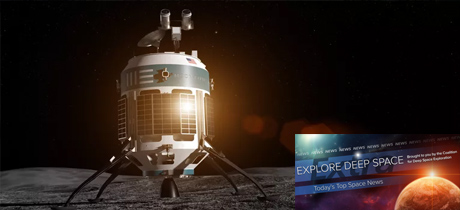In Today’s Deep Space Extra… NASA marks its 60th anniversary on Monday. NASA’s plans for a human tended lunar Gateway promise to bring the U.S., its international partners and the private sector together for a new era of human deep space exploration.
Human Space Exploration
Gateway project is humanity’s next big step into deep space
Coalition President and CEO in the News – Dr. Mary Lynne Dittmar
Florida Today (9/28): NASA’s Orion, Space Launch System (SLS) and lunar orbiting, human tended Gateway will soon come together as the agency and its commercial and international partners open a new door to deep space, one they don’t intend to close, writes Mary Lynne Dittmar, president and CEO of the Coalition for Deep Space Exploration, in an op-ed.
NASA (9/29): Monday, October 1, marks NASA’s 60th anniversary. Administrator Jim Bridenstine will air remarks at 1 p.m., EDT, noting the agency’s achievements after it set out to peacefully to explore outer space and the Earth’s place within it.
Washington Examiner (9/30): An editorial from the Examiner suggests that the U.S. as a nation has become too risk adverse when addressing the challenges of space exploration. Aiming for the stars will be unifying, the editorial contends.
Russia may build first manned base on Moon’s surface in 2030
TASS of Russia (9/29): In Russia, discussions emerged last week on the possibility of the country establishing a base on the Moon independently, or with NASA, or a consortium of other nations and achieving the goal by 2030 or shortly after. At first the lunar base would be occupied by explorers coming for short periods of time, then going. Eventually, it would be occupied full time.
Bipartisan efforts aimed at giving Space Station a lift
Houston Chronicle (9/30): Congress is voicing bipartisan support for an extension of NASA led International Space Station (ISS) operations from 2024 through at least 2030, writes Bob Mitchell, president of the Bay Area Houston Economic Partnership (BAHEP). It’ too soon to transition Space Station activities to the U.S. private sector, says Mitchell. The White House favors a transition by 2025.
Space Science
China plan SPACE MISSION in search for LUNAR WATER as Beijing push commercial spaceflights
The Express News of the UK (9/26): China plans four robotic lunar missions by 2030, each focused on discovering and exploiting lunar resources, with an emphasis on water ice deposits at the Moon’s North and South poles. A 2019 mission, Chang’e 5, will attempt to return lunar samples to Earth.
Pittsburgh company to play major role in NASA’s return to Moon
Coalition Member in the News – Astrobotic
KDKA-TV of Pittsburgh (9/28): Astrobotic has its eye on achieving precision landings on the Moon with its Peregrine lander and a search for water ice that could become a rocket propellant resource. The small company recently received a $10 million NASA grant to fashion a lander that can touch down within 100 meters of its target.
NASA hosts conference all about looking for signs of civilization beyond Earth
National Public Radio (9/27): Last week, Houston and the Lunar Planetary Institute played host to a three day conference on efforts to identify intelligent civilizations beyond the Earth by searching for technosignatures. Adam Frank, a University of Rochester astrophysicist and workshop participant, explains the objective in an interview.
Other News
New York Times (9/29): Under an agreement with the Securities and Exchange Commission (SEC) on Saturday, Musk is to step aside as chairman of Tesla, the electric car manufacturer, for three years and pay a $20 million fine for alleged misleading of investors with a Twitter message.
NASA stands by SpaceX, even as Elon Musk’s troubles grow
Washington Post (9/28): Elon Musk’s troubles with the U.S. Securities Exchange Commission (SEC) and automaker Tesla seem not to have eroded support for SpaceX within the nation’s civil and national security space communities. “While once it was a scrappy start-up that clawed and sued its way into the federal market, now it is a major federal contractor that is vital to the government’s space program,” the Post says of SpaceX.
Rogers, Cooper reject gold plating of Space Corps
Spacepolicyonline.com (9/27): Congress has yet settle on whether President Trump’s proposed Space Force, a sixth branch of the U.S. armed services, should be separate but equal to the Air Force or whether to split the Air Force into separate air and space components. Cost appears a factor.
ESA’s leader gets extra time for his vision of European space
SpaceNews.com (9/28): Without a lot fanfare, European Space Agency (ESA) director general Jan Woerner’s term has been extended by two years to match the terms of ESA’s current directors. With the extension, Woerner intends to focus on the future of the International Space Station (ISS), human lunar exploration, development of the Ariane 6 and the prospects for a European reusable launch vehicle as well as possible cooperation with China in human space flight.
China launches Kuaizhou-1A on CentiSpace-1-S1 mission
NASAspaceflight.com (9/28): The CentiSpace-1-S1 small satellite was launched by Exspace Technology Co., of China, early Saturday using a commercial rocket. The satellite’s mission was not announced but could be Earth observation.
Major Space Related Activities for the Week
Major space related activities for the week of October 1-6, 2018
Spacepolicyonline.com (9/30): Today, NASA observes its 60th birthday. Monday also marks the start of the International Astronautical Congress in Bremen, Germany. On Wednesday, Japan’s Hayabusa 2 mission to the asteroid Ryugu is to dispatch its third lander, the German/French Mascot, onto the surface of the asteroid for a fast paced, battery powered exploration session. Early Thursday, NASA astronauts Drew Feustel and Ricky Arnold join cosmonaut Oleg Artemyev for a return to Earth aboard their Soyuz MS-08 capsule, after serving aboard the International Space Station (ISS) since March.

